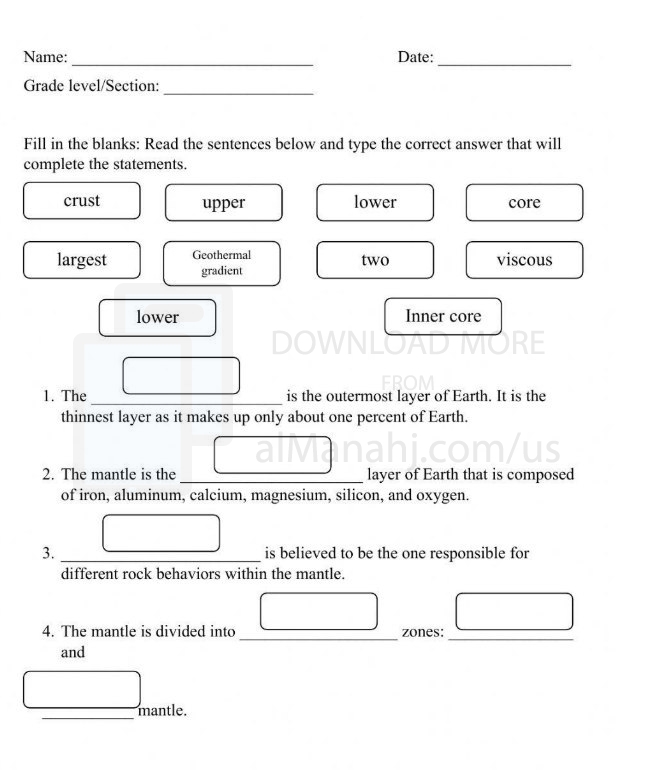| You are here: Almanahj Website ⇒ American curriculum ⇒ 10th Grade ⇒ Geology ⇒ Term 1 | ||
|---|---|---|
Worksheet about Internal Structure of Earth | ||
|---|---|---|
| Subject: Geology | ||
| 10th Grade | ||
| Term 1 | ||
| Year: 2023/2024 | ||
| Size: 214.7KB | ||
| Number of clicks: 153 | ||
| Publish date:November 26, 2023 | ||
| Added by: Eman | ||
| Last download date: 2024-09-13 17:59:13 | By: theodor cgjacla | |
| File info: The Earth's internal structure can be divided into several layers based on variations in composition, physical properties, and behavior. From the innermost to the outermost layers, the Earth can be classified into the following main components: 1. Inner Core: The innermost layer of the Earth is the inner core. It is a solid sphere primarily composed of solid iron and nickel. The immense pressure at the Earth's center keeps the inner core in a solid state despite its extremely high temperature, estimated to be around 5,000 to 6,000 degrees Celsius (9,000 to 10,800 degrees Fahrenheit). 2. Outer Core: Surrounding the inner core is the outer core, which is a liquid layer composed primarily of molten iron and nickel. The outer core is responsible for generating the Earth's magnetic field through a process called the dynamo effect. The temperature of the outer core is slightly lower than that of the inner core. 3. Mantle: Above the outer core is the mantle, the thickest layer of the Earth. The mantle is predominantly composed of solid rock, with high concentrations of iron, magnesium, and silicate minerals. It is further divided into two regions: the upper mantle and the lower mantle. The upper mantle is relatively rigid, while the lower mantle exhibits more plastic or semi-fluid behavior due to higher temperatures and pressures. Convection currents within the mantle drive plate tectonics and play a vital role in the Earth's geological activity. 4. Crust: The outermost layer of the Earth is the crust, which is the thinnest layer but the one we interact with directly. The crust is composed mainly of solid rock, including various minerals and elements. It is divided into two types: the continental crust, which forms the continents and is thicker but less dense, and the oceanic crust, which underlies the ocean basins and is thinner but denser. The crust is divided into numerous tectonic plates that float and interact with each other on the semi-fluid asthenosphere of the upper mantle. The transition between the mantle and the crust is known as the Mohorovičić discontinuity (Moho), while the boundary between the core and the mantle is known as the Gutenberg discontinuity. It is important to note that our knowledge of the Earth's internal structure is primarily based on indirect evidence, such as seismic waves and geological studies, as direct access to the deep layers of the Earth is limited. Ongoing research and technological advancements continue to enhance our understanding of the Earth's internal structure and processes. | ||
| Downloading link Worksheet about Internal Structure of Earth |
|---|
|
1701007778.pdf
The file is being prepared for download
|
| File images |
|---|
 |